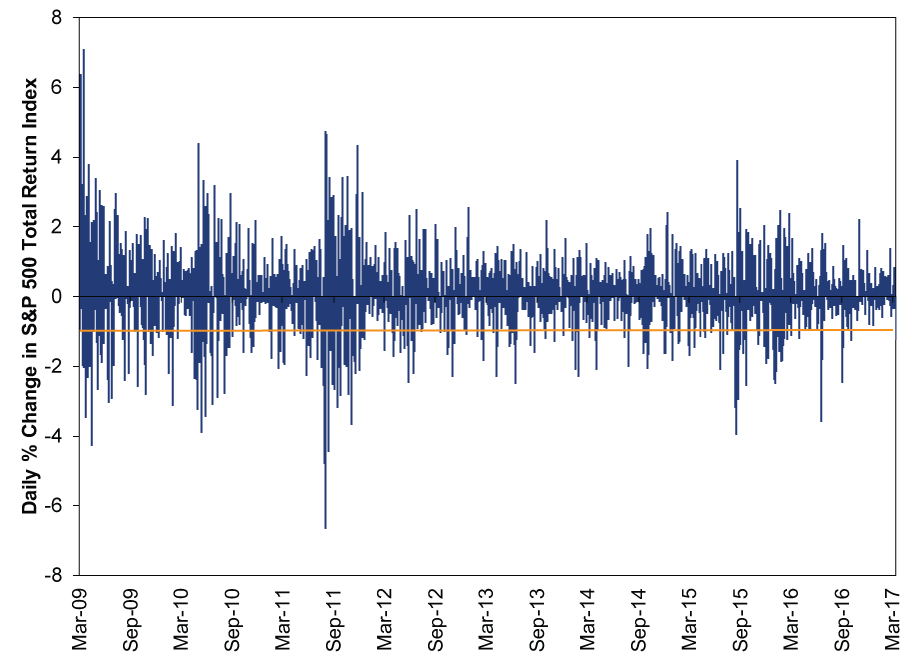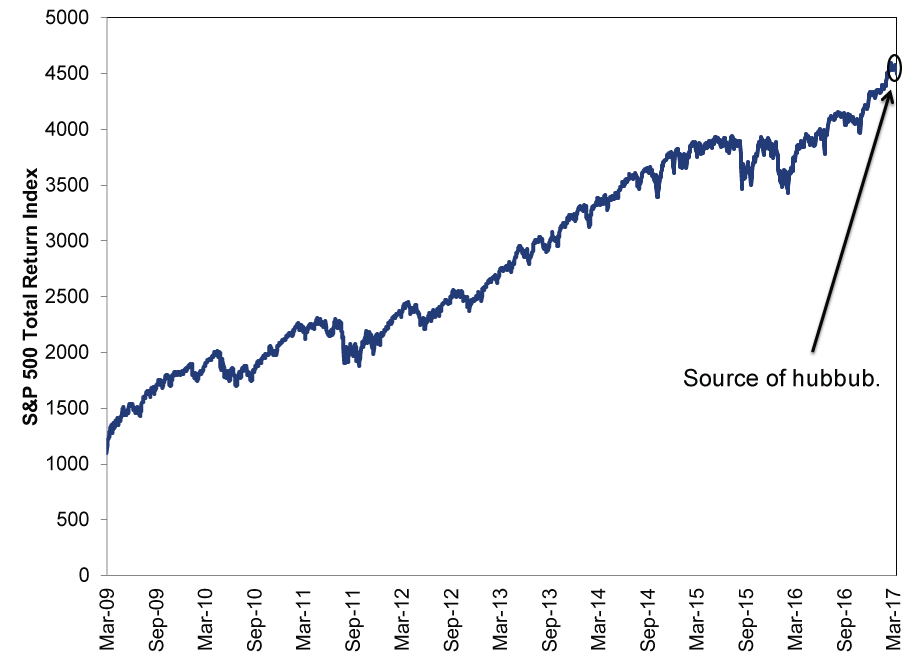Personal Wealth Management / Market Analysis
A Day in the Life of a Bull Market
A brief dip ended a lengthy quiet stretch for US stocks, but it doesn't foretell turbulence ahead.
Brace yourselves! The S&P 500 fell by more than 1% on Tuesday for the first time since October, sparking a spurt of analysis declaring volatility has returned, investors are "selling off" as they lose faith in the rally, and larger losses will soon follow. But rather than agonize over the decline's causes or implications, investors are best served to remain cool-headed. Daily dips like Tuesday's aren't actionable or ominous.
A 1% swing in either direction isn't huge by most standards. Most days, it wouldn't warrant a second glance-volatility is common in bull markets, especially day-to-day. But Tuesday's drop occurred after nearly half a year of calm, giving the media something new to write about, and perhaps magnifying the decline in investors' minds.
In proper context, though, Tuesday doesn't look so unnerving. The S&P 500 has fallen by at least one percent 232 times during this bull market, accounting for 11.5% of trading days.[i] Exhibit 1 is noisy, but focus on the orange line-everything below it reflects a -1% or worse single-day fall. It's crowded down there! The lull since October doesn't make the occurrence any more notable.
Exhibit 1: -1.0% Dips Are Frequent

Source: FactSet, as of 3/22/17. S&P 500 Total Return Index daily percentage change, 3/9/2009 - 3/22/2017.
Set against the whole bull market, the drop is imperceptible.
Exhibit 2: Tuesday in Context

Source: FactSet, as of 3/22/17. S&P 500 Total Return Index, 3/9/2009 - 3/22/2017.
We wouldn't sweat the small volatility pickup, either. Stocks aren't serially correlated, which means past price movement-up, down or flat-doesn't affect future. Thus, the probability of an up or down day doesn't depend on what happened the day before, just like the probability of getting heads when you flip a coin doesn't improve if you got tails five times in a row. This is the Gambler's Fallacy, and it leads investors to a bad place.
Even were volatility to escalate, this wouldn't say anything about stock prices. People always think of volatility as "down," but it's really just movement. A 1% up day is as volatile as a -1% down day. Wishing for only the good kind, every single day, is fanciful. Declines like Tuesday's are a way of paying the piper. You have to take the good with the bad.
This is why searching for daily volatility's cause is not only futile, but unnecessary. Still, many tried, claiming fading prospects for tax, healthcare and infrastructure reforms were disillusioning investors. However, none of this legislation got way less likely on Tuesday, and we doubt markets only just realized the obstacles they face. Plus, considering all this proposed legislation would create winners and losers, it is entirely possible markets have rallied the past few months in part because they subconsciously realized gridlock probably stalls radical change. As we've written, it's a myth that rising markets require Trump's following through on campaign promises.
With precious few exceptions, deciphering daily movements' causes is impossible-markets are too complex. Tuesday's news was a mishmash of good, bad and "good or bad depending on who you ask." Here's a list:[ii]
- UK factory orders rose.
- So did UK inflation.
- A centrist candidate gained in the French presidential election.
- A survey said stocks are overvalued.
- The Japanese fiscal year ends this month.
- Canadian retail sales expanded.
- A Florida man pulled an alligator out of a suburban storm drain.
- US shale firms kept taking market share from OPEC.
- An obscure technical gauge flashed a warning signal.
- An economic confidence gauge rose slightly.
- The White House pronounced March 21 National Agriculture Day.
Obviously not all these developments are equally important, but there is a lot happening! How does each story affect investors, and how much? Impossible to say. No one administers an all-investor survey at the closing bell each day, tallies up who bought and sold and why, and distributes the results to pundits so they can tell you why stocks rose or fell. Cited reason(s) for daily price movements are just guesses.
Discounting daily moves can be tough, with overdramatic coverage pumping up worries and urging myopic action. But reacting generally isn't the solution-it's the problem. Hasty, volatility-driven decisions have kept many from capturing stocks' gains during this bull. So when more Tuesdays strike (and they will!), take a deep breath, and a long view-one that matches your goals, which almost certainly don't depend on what markets do tomorrow, next week or next month.
If you would like to contact the editors responsible for this article, please message MarketMinder directly.
*The content contained in this article represents only the opinions and viewpoints of the Fisher Investments editorial staff.
Get a weekly roundup of our market insights
Sign up for our weekly e-mail newsletter.

You Imagine Your Future. We Help You Get There.
Are you ready to start your journey to a better financial future?

Where Might the Market Go Next?
Confidently tackle the market’s ups and downs with independent research and analysis that tells you where we think stocks are headed—and why.





